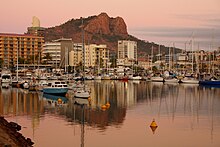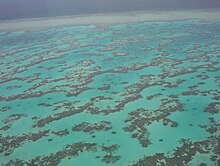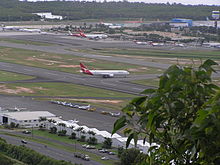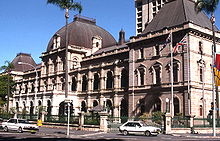Queensland: Difference between revisions
Tag: references removed |
Mark Arsten (talk | contribs) m Reverted edits by 203.25.120.53 (talk) to last revision by ClueBot NG (HG) |
||
| Line 77: | Line 77: | ||
==Etymology== |
==Etymology== |
||
The state was named in honour of [[Queen Victoria]],<ref>[http://www.piulapublications.com/Placenames/page54.html Place Names]</ref> who on 6 June 1859 signed Letters Patent separating the colony from New South Wales. At the time, Queen Victoria was a generally popular monarch, and she preferred an [[eponymous]] name for the new colony over ''Cooksland'', which had been suggested by the influential local [[Presbyterian]] minister [[John Dunmore Lang]] in honour of English navigator [[James Cook]].<ref>{{cite web|url=http://gutenberg.net.au/dictbiog/0-dict-biogL.html#lang2 |title=Dictionary of Australian Biography |publisher=Gutenberg.net.au |accessdate=4 August 2010}}</ref><ref>{{cite web|url=http://www.q150.qld.gov.au/AboutUs/Birth.aspx |title=Queensland Government – Q150 |publisher=Q150.qld.gov.au |date=11 June 2010 |accessdate=4 August 2010}}</ref> |
|||
my name is jack cutts i am da man brah |
|||
==History== |
==History== |
||
Revision as of 01:59, 15 February 2012
Template:Australia state or territory
23°0′S 143°0′E / 23.000°S 143.000°E Queensland is a state of Australia, located in the north-east of the country. It is bordered by the Northern Territory, South Australia and New South Wales to the west, south-west and south respectively. To the east, Queensland is bordered by the Coral Sea and Pacific Ocean. The state is Australia's second largest by area, following Western Australia, and the country's third most populous after New South Wales and Victoria. The capital and largest city in the state is Brisbane.
Queensland was first occupied by Indigenous Australians and Torres Strait Islanders, who arrived between 40,000 and 65,000 years ago, according to various dating methods.[1] Queensland was made a British Crown Colony that was separated from New South Wales on 6 June 1859, a date now celebrated state-wide as Queensland Day.
Queensland is often referred to as Australia's Sunshine State. Queensland's current Premier is Anna Bligh of the Australian Labor Party.
Etymology
The state was named in honour of Queen Victoria,[2] who on 6 June 1859 signed Letters Patent separating the colony from New South Wales. At the time, Queen Victoria was a generally popular monarch, and she preferred an eponymous name for the new colony over Cooksland, which had been suggested by the influential local Presbyterian minister John Dunmore Lang in honour of English navigator James Cook.[3][4]
History
The history of Queensland spans thousands of years, encompassing both a lengthy indigenous presence, as well as the eventful times of post-European settlement. Estimated to have been settled by Indigenous Australians approximately 40,000 years ago, the north-eastern Australian region was explored by Dutch, Portuguese and French navigators before being encountered by Captain James Cook in 1770. The Australian Labor Party has its origin as a formal organisation in Queensland and the town of Barcaldine is the symbolic birthplace of the party.[5] The state has witnessed frontier warfare between European settlers and Indigenous inhabitants, as well as the employment of cheap Kanaka labour sourced from the South Pacific. June 2009 marked the 150 anniversary of its creation as a separate colony from New South Wales.[6] A rare record of early settler life in north Queensland can be seen in a set of ten photographic glass plates taken in the 1860s by Richard Daintree, in the collection of the National Museum of Australia.[7]
Geography

Queensland is bordered to the north by the Torres Strait with Boigu Island off the coast of New Guinea representing the absolute northern extreme of the territory. The triangular Cape York Peninsula, which points toward New Guinea is the northernmost part of the state's mainland. West of the peninsula's tip, northern Queensland is bordered by the Gulf of Carpentaria, while the Coral Sea— an arm of the Pacific Ocean— borders Queensland to the east. To the west, Queensland is bordered by the Northern Territory, at the 138°E longitude, and to the south-west by the north-eastern corner of South Australia.
In the south, there are three sections that comprise its border: the watershed from Point Danger to the Dumaresq River; the river section involving the Dumaresq, the MacIntyre and the Barwon; and 29°S latitude (including some minor historical encroachments below the 29th parallel) over to the South Australian border.
The state capital is Brisbane, located on the coast 100 kilometres (60 mi) by road north of the New South Wales border. The state is divided into several officially recognised regions. Other smaller geographical regions of note include the Atherton Tablelands, the Granite Belt, and the Channel Country in the far south-west.
Queensland has many places of natural beauty, including: the Sunshine Coast and the Gold Coast having some of the state's most popular beaches; the Bunya Mountains and the Great Dividing Range with numerous lookouts, waterfalls and picnic areas; Carnarvon Gorge; Whitsunday Islands and Hinchinbrook Island.
The state contains six World Heritage listed preservation areas: Australian Fossil Mammal Sites at Riversleigh in the Gulf Country, Gondwana Rainforests of Australia, Fraser Island, Great Barrier Reef, Lamington National Park and the Wet Tropics of Queensland.
Climate
Because of its size, there is significant variation in climate across the state. Low rainfall and hot summers are typical for the inland west, a monsoonal 'wet' season in the far north, and warm temperate conditions along the coastal strip. Inland and in southern ranges low minimum temperatures are experienced. The climate of the coastal strip is influenced by warm ocean waters, keeping the region free from extremes of temperature and providing moisture for rainfall.[8]

There are five predominate climatic zones in Queensland,[9] based on temperature and humidity:
- hot humid summer (far north and coastal)
- warm humid summer (coastal elevated hinterlands and coastal south-east)
- hot dry summer, mild winter (central west)
- hot dry summer, cold winter (southern west)
- temperate – warm summer, cold winter (inland south-east, e.g. Granite Belt)
However, most of the Queensland populace experience two weather seasons: a "winter" period of rather warm temperatures and minimal rainfall and a sultry summer period of hot, sticky temperatures and higher levels of rainfall.
The annual mean statistics[10] for some Queensland centres is shown below:
| City | Min. Temp | Max. Temp | No. Clear days | Rainfall |
|---|---|---|---|---|
| Brisbane | 15.7 °C (60.3 °F) | 25.5 °C (77.9 °F) | 113.1 | 1,149.1 mm (45.24 in)[11] |
| Mackay | 19.0 °C (66.2 °F) | 26.4 °C (79.5 °F) | 123.0 | 1,570.7 mm (61.84 in)[12] |
| Cairns | 20.8 °C (69.4 °F) | 29.0 °C (84.2 °F) | 89.7 | 2,006.3 mm (78.99 in)[13] |
| Townsville | 19.8 °C (67.6 °F) | 28.9 °C (84.0 °F) | 120.9 | 1,136.7 mm (44.75 in)[14] |
The highest maximum temperature observed in the state is 49.5 °C (121 °F) at Birdsville on 24 December 1972 (The temperature of 53.1 °C (128 °F) at Cloncurry on 16 January 1889 is not considered reliable; the figure quoted from Birdsville is the next highest, so that record is considered as being official).
The lowest minimum temperature is −10.6 °C (13 °F) at Stanthorpe on 23 June 1961 and at The Hermitage on 12 July 1965.[15]
Demographics

| Queensland population by year | |
|---|---|
| 1901 | 498,129 |
| 1954 | 1,318,259 |
| 1961 | 1,518,828 |
| 1971 | 1,851,485 |
| 1981 | 2,345,208 |
| 1991 | 3,029,950 |
| 2001 | 3,628,946 |
| 2007 | 4,181,400 |
| 2011 | 4,516,200 |
| 2021 | 6,553,300 |
| 2056 | 10,921,300 |
| Source: Australian Bureau of Statistics[16][17] | |
A smaller proportion of Queensland's population lives in the capital city than any other mainland state. As of June 2004 the capital city represented 45.7% of the population; for the whole country, capital cities represented 63.8% of the total population.
- Christian: 70.9%:
- Roman Catholic: 24.9%
- Anglican: 22.3%
- Uniting: 8.4%
- Lutheran: 2.1%
- Other: 13.2%
- Non-Christian: 2.3%
- No Religion: 14.8%
- Not Stated: 12.0%
Population trends
On 9 December 2005, the population of Queensland officially reached 4 million. According to Queensland's Office of Economic and Statistical Research the estimated population of the state at the end of 2007 was 4,228,290 which is almost 20% of Australia's total. For many years until 2008, Queensland was the fastest growing state in Australia. At its peak growth in 2007, it was estimated that over 1,500 people moved to the state per week including 1,000 to the southern part of the state alone and the state recorded a TFR of 2.1, the highest since 1977.[18] Queensland's growth rate has since been surpassed by Western Australia[19]).
Urban and rural
| YEAR | Urban | Rural | TOTAL |
|---|---|---|---|
| 1861 | 15,348 | 14,711 | 30,059 |
| 1864 | 30,954 | 30,513 | 61,467 |
| 1868 | 40,306 | 59,595 | 99,901 |
| 1871 | 51,425 | 68,679 | 120,104 |
| 1876 | 95,775 | 77,508 | 173,283 |
| 1881 | 112,323 | 101,202 | 213,525 |
| 1886 | 116,056 | 206,797 | 322,853 |
| 1891 | 168,884 | 224,834 | 393,718 |
| 1901 | 204,871 | 293,258 | 498,129 |
| 1911 | n.a. | n.a. | 605,813 |
| 1921 | 393,666 | 359,014 | 755,972 |
| 1933 | 498,892 | 444,589 | 947,534 |
| 1947 | 660,958 | 443,570 | 1,106,415 |
| 1954 | 962,400 | 352,888 | 1,318,259 |
| 1961 | 1,158,446 | 358,394 | 1,518,828 |
| 1966 | 1,282,332 | 398,297 | 1,682,688 |
| 1971 | 1,448,024 | 375,376 | 1,827,065 |
| 1976 | 1,633,141 | 401,754 | 2,037,194 |
| 1981 | 1,816,382 | 476,264 | 2,295,123 |
| 1986 | 2,041,542 | 542,944 | 2,587,315 |
| 1991 | 2,359,510 | 616,907 | 2,977,810 |
| 1996 | 2,721,115 | 647,735 | 3,368,850 |
| 2001 | 3,050,553 | 602,697 | 3,655,139 |
| 2006 | 3,456,104 | 588,945 | 4,046,875 |
| Source: Queensland Government Office of Economic & Statistical Research[20] | |||
Economy

Queensland's economy has enjoyed a boom in the tourism and mining industries over the past 20 years. A sizeable influx of interstate and overseas migrants, large amounts of federal government investment, increased mining of vast mineral deposits and an expanding aerospace sector have contributed to the state's economic growth. The 2008–09 saw the expansion slow to just 0.8% the state's worst performance in 18 years.[21]
Between 1992 and 2002, the growth in the Gross State Product of Queensland outperformed that of all the other states and territories. In that period Queensland's GSP grew 5.0% each year, while growth in Australia's Gross Domestic Product (GDP) rose on average 3.9% each year. Queensland's contribution to the Australian GDP increased by 10.4% in that period, one of only three states to do so.[22]
In 2003 Brisbane had the lowest cost of living of all Australia's capital cities. In late 2005 Brisbane was the third most expensive capital for housing after Sydney and Canberra and just ahead of Melbourne by $15,000.
Primary industries include: bananas, pineapples, peanuts, a wide variety of other tropical and temperate fruit and vegetables, grain crops, wineries, cattle raising, cotton, sugar cane, wool and a mining industry including bauxite, coal, silver, lead, zinc, gold, and copper. Secondary industries are mostly further processing of the above-mentioned primary produce. For example, bauxite is shipped by sea from Weipa and converted to alumina at Gladstone.[23] There is also copper refining and the refining of sugar cane to sugar at a number of mills along the eastern coastline. Major tertiary industries are the retail trade and tourism.
Tourism


Tourism is Queensland's leading tertiary industry with millions of interstate and overseas visitors flocking to the Sunshine State each year. The industry generates $4.0 billion annually, accounting for 4.5% of Queensland's GSP.[24] Queensland is a state of many landscapes that range from sunny tropical coastal areas, lush rainforests to dry inland areas.
The main tourist destinations of Queensland include, Brisbane, Cairns, Port Douglas and the Daintree Rainforest, Gold Coast, the Great Barrier Reef, Hervey Bay and nearby Fraser Island, Townsville, Magnetic Island, North Stradbroke Island and South Stradbroke Island, Sunshine Coast, Hamilton Island, Daydream Island and the Whitsundays known for Airlie Beach and Whitehaven Beach.

The Gold Coast of Queensland is also sometimes referred to as "Australia's Theme Park Capital", with five major amusement parks. These are Dreamworld, Movie World, Sea World, Wet 'n' Wild and WhiteWater World.
There are numerous wildlife parks in Queensland. On the Gold Coast there is Currumbin Wildlife Sanctuary at Currumbin and David Fleay Wildlife Park at Burleigh Heads. On the Sunshine Coast there is UnderWater World at Mooloolaba and Australia Zoo near Beerwah/Glass House Mountains, home of Steve Irwin until his death in 2006.
Lone Pine Koala Sanctuary at Fig Tree Pocket and Brisbane Forest Park at The Gap are located in Brisbane. North of Brisbane is Alma Park Zoo which is relocating to Logan City and Kumbartcho Wildlife Sanctuary which was originally called Bunya Park Wildlife Sanctuary.
Accommodation in Queensland caters for nearly 22% of the total expenditure, followed by restaurants/meals (15%), airfares (11%), fuel (11%) and shopping/gifts (11%).[25]
Transport

Queensland is served by a number of National Highways and, particularly in South East Queensland, high quality motorways such as the M1. The Queensland government Department of Transport & Main Roads oversees the development and operation of main roads and public transport, including taxis and local aviation.
Principal rail services are provided by Queensland Rail and Pacific National, predominantly between the major towns along the coastal strip east of the Great Dividing Range.
Major seaports include the Port of Brisbane and subsidiary ports at Gladstone, Townsville and Bundaberg. There are large coal export facilities at Hay Point / Dalrymple Bay, Gladstone and Abbot Point. Sugar is another major export, with facilities at Lucinda and Mackay.
Brisbane Airport is the main international and domestic gateway serving the state. Gold Coast Airport, Cairns International Airport and Townsville Airport are the next most prominent airports, all with scheduled international flights. Other regional airports, with scheduled domestic flights, include Great Barrier Reef Airport, Hervey Bay Airport, Mackay Airport, Mount Isa Airport, Proserpine / Whitsunday Coast Airport, Rockhampton Airport, and Sunshine Coast Airport.
South East Queensland has an integrated public transport system operated by the TransLink Transit Authority, which provides services bus, rail and ferry services through contracted bus and ferry operators and Queensland Rail. The TransLink network operates a fare system which allows a single ticket to be used across all modes for the same price irrespective of the number of transfers made on the trip. Regional bus and long-distance rail services are also provided throughout the State. Local bus services are also available in most regional centres.
Governance

Executive authority is vested in the Governor, who represents and is appointed by Elizabeth II on the advice of the Premier. The current governor is Ms. Penelope Wensley, AO. The head of government is the Premier, who is appointed by the Governor but must have the support of the Legislative Assembly. The current Premier is Anna Bligh, of the Australian Labor Party. Other ministers, forming the Executive Council, are appointed by the governor from among the members of the Legislative Assembly on the Premier's recommendation.
The Queensland Parliament or the Legislative Assembly, is unicameral. It is the only Australian state with a unicameral legislature. A bicameral system existed until 1922, when the Legislative Council was abolished by the Labor members' "suicide squad" so called because they were appointed for the purpose of voting to abolish their own offices.[26] The Parliament is housed in the 19th century Parliament House and 20th century Parliamentary Annexe in Brisbane.
The judicial system of Queensland consists of the Supreme Court and the District Court, established by the Queensland Constitution, and various other courts and tribunals established by ordinary Acts of the Queensland Parliament.
In 2001 Queensland adopted a new codified constitution, repealing most of the assorted Acts of Parliament that had previously made up the constitution. The new constitution took effect on 6 June 2002, the anniversary of the formation of the colony of Queensland by the signing of Letters Patent by Queen Victoria in 1859.
Local government
Local government is the mechanism by which towns and districts can manage their own affairs to the extent permitted by the Local Government Act 1993–2007. Queensland is divided into 73 local government areas which may be called Cities, Towns, Shires or Regions.[27]
Each area has a council which is responsible for providing a range of public services and utilities, and derives its income from both rates and charges on resident ratepayers, and grants and subsidies from the State and Commonwealth governments.[28]
Universities

- Australian Catholic University (Brisbane campus)
- Bond University
- Central Queensland University
- Griffith University
- James Cook University
- Queensland University of Technology
- University of Queensland
- University of Southern Queensland
- University of the Sunshine Coast
Sports


The state of Queensland is represented in all of Australia's national sporting competitions and is also host to a number of domestic and international sporting events. The most popular winter and summer team sports are Rugby league, Rugby union and cricket, respectively. The annual rugby league State of Origin series is a major event in the Queensland sporting calendar, with the Queensland Maroons in 2011 winning a record sixth series in a row. The Brisbane Broncos are the state's most successful team of any sport, having won 3 premierships in the NRL rugby league era and 6 in total during their 23 year existence.
Queensland's dominance is not restricted to rugby league. The early part of this decade saw the AFL's Brisbane Lions claim a hat-trick of premierships between 2001–2003 inclusive, and coming so close to a record-equalling fourth, whilst recently Brisbane Roar FC won its first A-League title in March 2011, the culmination of a season of long dominance in which it has not lost since September last year. Just four years after being branded "the joke of rugby", the Queensland Reds won its first Super Rugby title in July 2011.
Swimming is also a popular sport in Queensland, with a majority of Australian team members and international medalists hailing from the state. At the 2008 Summer Olympics, Queensland swimmers won all six of Australia's gold medals, all swimmers on Australia's three female (finals) relays teams were from Queensland, two of which won gold.
Major professional teams include:
- Australian Football: Brisbane Lions, Gold Coast Suns
- Basketball: Townsville Crocodiles, Cairns Taipans and the Gold Coast Blaze
- Cricket: Queensland Bulls, Brisbane Heat
- Football (soccer): Brisbane Roar, North Queensland Fury (no longer in the A-League) and Gold Coast United
- Netball: Queensland Firebirds
- Rugby League:
- Representative: Queensland Maroons
- Clubs: Brisbane Broncos, Gold Coast Titans and the North Queensland Cowboys
- State Competition: Queensland Cup
- Rugby Union: Queensland Reds
Events include:
See also
- Queensland Council of Unions
- Queensland Day
- Queensland Expatriate Awards
- Queensland State Archives
- 2010–2011 Queensland floods
- United Nations Association of Australia (Queensland) Community Award
Lists:
- Governors of Queensland
- List of highways in Queensland
- List of Queenslanders
- List of schools in Queensland
- Premiers of Queensland
- Protected areas of Queensland
Famous people From Queensland
Cody Simpson, Gold Coast, Queensland
References
- ^ Australia. "Dreaming Online: Indigenous Australian Timeline". Dreamtime.net.au. Retrieved 4 August 2010.
- ^ Place Names
- ^ "Dictionary of Australian Biography". Gutenberg.net.au. Retrieved 4 August 2010.
- ^ "Queensland Government – Q150". Q150.qld.gov.au. 11 June 2010. Retrieved 4 August 2010.
- ^ Karl Bitar. "Labor History: Timeline: Foundations: Colonial Origins". Retrieved 24 August 2010.
- ^ "Queensland's History". Qld.gov.au. 29 January 2009. Retrieved 4 August 2010.
- ^ Richard Daintree's glass plates, National Museum of Australia
- ^ National Climate Centre. "Australian Government, Bureau of Meteorology – Climate of Queensland". Bom.gov.au. Retrieved 4 August 2010.
- ^ "Australian Government, Bureau of Meteorology – Australian climatic zones". Bom.gov.au. Retrieved 4 August 2010.
- ^ "Australian Government, Bureau of Meteorology – Climate statistics for Australian locations". Bom.gov.au. 19 July 2010. Retrieved 4 August 2010.
- ^ "Brisbane Regional Office". Climate statistics for Australian locations. Bureau of Meteorology. Retrieved 26 September 2010.
- ^ "Mackay M.O." Climate statistics for Australian locations. Bureau of Meteorology. Retrieved 26 September 2010.
- ^ "Cairns Aero". Climate statistics for Australian locations. Bureau of Meteorology. Retrieved 26 September 2010.
- ^ "Townsville Aero". Climate statistics for Australian locations. Bureau of Meteorology. Retrieved 26 September 2010.
- ^ "Rainfall and Temperature Records: National" (PDF). Bureau of Meteorology. Retrieved 14 November 2009.
- ^ "ABS.gov.au". ABS.gov.au. Retrieved 4 August 2010.
- ^ "ABS.gov.au". ABS.gov.au. Retrieved 4 August 2010.
- ^ "3301.0 – Births, Australia, 2008". Australian Bureau of Statistics. Retrieved 10 January 2010.
- ^ Tara Ravens (2 July 2008). "Couriermail.com.au". Couriermail.com.au. Retrieved 4 August 2010.
- ^ Queensland Government Office of Economic & Statistical Research, Historical Tables, Demography, 1823 to 2008 (Q150 release), Population, urban and rural, Queensland, 1861 to 2006 (accessed 25 November 2010, xls file)
- ^ Tom Dusevic (17 December 2009). "Queensland falls back with the pack". The Australian. News Limited. Retrieved 10 January 2010.
- ^ "1387.3 – Queensland in Review, 2003". Australian Bureau of Statistics. Retrieved 10 January 2010.
- ^ "Gladstone". Comalco.com. Rio Tinto Aluminium. Retrieved 11 January 2010.
- ^ "About TQ – Profile". Tourism Queensland. Retrieved 6 January 2010.
- ^ "Tourism related information and statistics". Discoverqueensland.com.au. Retrieved 4 August 2010.
- ^ Wanna, John (2003). "Queensland". In Moon, Campbell; Sharman, Jeremy (eds.). Australian Politics and Government: The Commonwealth, the States and Territories. Cambridge, United Kingdom: Cambridge University Press. p. 47. ISBN 0521825075. Retrieved 15 November 2011.
{{cite book}}: Cite has empty unknown parameter:|coauthors=(help) - ^ Local Government Act 1993, s.34. (Reprint 11E, as in force at 22 November 2007.)
- ^ Department of Local Government, Sport and Recreation (Queensland) (26 July 2007). "Rates and valuations". Retrieved 5 April 2008.

